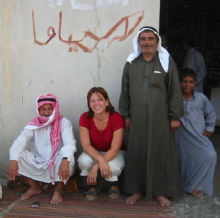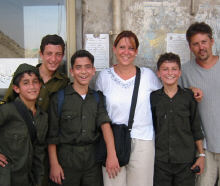A Woman Can’t Go to the Middle East
Syria
 |
Locals in Deir el Zor, Syria
![]()
When I told family and friends that I was going to travel through the Middle East, they said I was crazy. Their dire warnings and predictions stated that as a woman I would be forced to wear a headscarf. Men would mercilessly hound me. I’d have to do all my sight-seeing with a group because women aren’t allowed to do anything by themselves, DON’T YOU KNOW? I was determined to prove them wrong, and this is what I found…
I had been in Syria for about a week when I decided that it was OK to get away with a little cooler clothing. I put on my sleeveless sundress and set out for an afternoon in the bazaar. Along the way I stopped at the pizza place where I had eaten the night before. The man behind the counter recognized me and laughed when he saw what I was wearing. He gestured to ask why my shoulders weren’t covered, but it was more of a joke than an admonition. As I walked around the bazaar, I did not receive any more attention than the previous day’s visit to the same place. This was interesting since the time before I had been with two of my male friends. Now I wasn’t being approached even though I was by myself.
In fact, the only time I was “hit on” by a Syrian man was when I was wearing long pants and a baggy T-shirt. He was a carpet seller, surprise surprise. He offered to show me the women’s quarter for shopping since I needed to buy my hejab, the required cover-up outfit for Iran. I hadn’t spoken more than five minutes with him when his arm was around my waist. I was amused by the familiarity but quickly removed myself from his embrace. This didn’t deter him from trying to invade my personal space again, and this time I smacked his hands. Did this shut him down? No, and at the end of failing to drop him in the bazaar, I finally told him that we probably wouldn’t be seeing each other again, no, we did not have a future, and his continued attempts were fruitless. At this point I was able to free myself of his octopus-styled moves and get back to the hotel where I was meeting friends for dinner.
In Aleppo, I set out once again to try and find a hejab. Syria was a cheaper place to buy these outfits than Turkey, where they gouge the unwary female traveler who is making an attempt to cover up before arriving at the Iranian border. This time I was wearing the same outfit – long pants, baggy T-shirt, hair uncovered. The only attention I got from the men in the bazaar were the ones who came to watch my transformation.
I am a Caucasian descended from German grandparents. However, when I put a scarf on my head, the Arab features I didn’t know I had jump out.
“Are you Arab? Your parents must be Arab, at least one of them. Are you Syrian? No, no, you can’t be Canadian, you’re obviously Syrian.”
 |
Local boys in Aleppo, Syria
![]()
This may explain why I wasn’t approached more often in the bazaars and on the streets the way many other female travelers I met had been. Perhaps I was left alone because I was perceived to be one of the locals, despite my untraditional clothing.
The same response came at me in every Arab country I visited – I was Lebanese, Jordanian, or Iranian. With the exception of the carpet seller in Damascus and one very touchy-feely cab driver in Beirut, I was pretty much left alone or treated with more respect than I would have imagined.
In Iran I encountered the same sort of respect, although it wasn’t immediately apparent. One of the unexpected difficulties came in the form of no physical contact between men and women. I was surprised by how closed off I felt from the people I was meeting because I wasn’t able to extend my hand in friendship. I had to learn how to compensate for this lack of physical communication by making eye contact and nodding my head. This did seem to convey a form of friendly greeting and was returned in the same manner. That hurdle being overcome, the next one was a little harder.
Whenever I went anywhere with one of my male friends, even if I started the conversation, the Iranian man would invariably nod to my friend, not to me. It is easy to see how some people interpret this as a snub on the woman, or a preference for the man, but I think it’s simply because the men in these areas have not had to deal with women on a familiar basis in the past, and only defer to the man because that is what is normal for them. Most times, after overcoming their shyness on addressing a woman, the men became eager to make me feel comfortable.
The following treatment became almost royal in nature. One evening I was given a tour of Esfahan by yet another carpet seller on the back of his motorbike. I met a family who invited me into their home. When I entered the front door, I was informed by the father in very strict tones that I was not to wear my scarf in his house. “This is a free place here!” (It is important to note that unlike Lebanon, Jordan, and Syria, in Iran it is the law that women cover their heads.) I was even able to convince one taxi driver in the east of Iran to let me drive his cab around the city.
Aside from Iran and eastern Pakistan, I was not forced to cover my head. I was not mercilessly hounded by men. Nor did I have to do things in groups. In fact, I had some of my most favourite encounters with locals when I was by myself. As for the perceived oppression of having to cover one’s head, many of the Muslim women I met actually chose to wear the scarf because they felt that is what good Muslim women do. It is a personal choice for many and they do not feel burdened by this decision.
For myself, I did not feel that the scarf was an infringement upon my rights. The only time it frustrated me was when I was pitching my tent and I’d end up pegging it and my head to the ground when the ends got in the way. When I finally arrived in India and I could take the scarf off, it felt strange, a bit like being naked in public. After five weeks of having to cover my head, I was unused to showing the world my hair. I was ashamed of the roots at this point, but no one seemed to notice. I guess my main observation of the scarf for female travelers is that it will get to you only if you let it. Otherwise, it’s part of the experience of the Middle East and one that is definitely worth having.
In the end, the most difficult thing about being a female in the Middle East was trying to find a suitable place to go to the bathroom in the desert – flat, no bushes, miles of visibility from the highway. Trust me, some of these experiences are worth stories all their own.